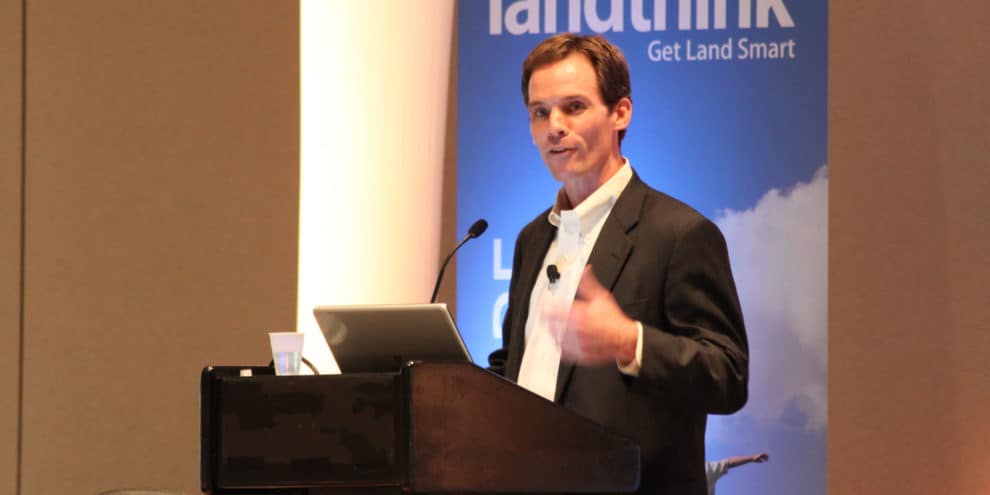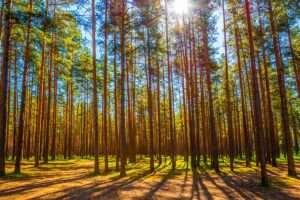Brooks C. Mendell, Ph.D., is president and founder of Forisk Consulting, a Georgia-based firm that specializes in forest-industry, timber-REIT, bioenergy and timber-market research. Mendel has nearly 20 years of consulting, operating and equity research experience in these areas.
He approaches timberland investing as an exercise in thoroughly researching the site-specific characteristics of a property’s timber, its local market, investor priorities and “knowing what is knowable” in using projected revenue models.
Mendell is a scheduled speaker at the first LANDTHINK Summit to be held at the Gwinnett Center in Duluth, Ga., on September 30, 2010. Following work with Weyerhaeuser, Accenture and the University of Georgia, he started Forisk in 2004.
His unedited answers to my questions appear below:
1. Do you think timberland is currently priced above, at or below market in terms of its intrinsic values (defined however you want), and why? What’s driving current valuations? Do you see a change in valuation drivers in the future?
I worry less about regional or asset class-specific values and much more about individual properties and local timber markets. Timberland price-to-value metrics depend critically on the local wood basin and forest stocking level of the given property. Broad-based per-acre values used to evaluate regional averages can mislead investors into thinking they are performing at, above or below expectations. Over the past two years, key changes in valuation drivers include (1) the approach to building in HBU (development) opportunities into valuation models and (2) the selection and application of the discount rate. Today, rather than sifting through timberland properties seeking to find suitable development potential, investors are taking a forest-centric approach to evaluating timberland properties and asking “what is this asset worth to me, assuming it will generate returns primarily from growing and selling trees?”
2. Do you use or recommend a general valuation formula for determining which investments to make, such as x% of acquisition cost in merchantable timber or a projected 10-year pay off of acquisition cost? When using DCF analysis, what minimum target do you use? Do you have non-revenue hurdles against which you measure timberland investment performance?
No. In supporting valuation work, we focus on two things. First, we clarify, possibly to the point of annoyance, the priorities of the investor. Being specific on this point is critical to any valuation efforts as it affects assumptions, investment periods and negotiations. For example, a client whose objective is to own forestlands solely from a “maximizing long-term returns” perspective differs from maximizing annual cash flows which differs from clients who own forests to help source a wood-using mill or bioenergy project to clients who prioritize recreational potential. We find, in cases, the clients themselves may not be clear on their own priorities, so we work through this to bring clarity to any valuation and due diligence work.
Second, we attempt to “know what’s knowable” with respect to data for the DCF model, local wood markets, and client hurdle rates. We have the opportunity to review valuation models from a range of investors and analysts and find that, typically, ~30% have a math or Excel error, and most have made assumptions about costs, volumes or prices that could be strengthened with minimal work. So, in the DCF, we want, to the extent possible, “know what’s knowable” and get it right relative to the investor’s priorities. If we’re not clear on what the investor values, the DCF can provide a valuation inconsistent with the true ownership objectives.
3. Do you anticipate any significant shifts in the market (either positive or negative) for timber fiber/logs during the next 15 years? Do you anticipate any technology change, shift in end uses, environmental issues, trade restrictions/expansion etc. that would positively or negatively affect current production trends and markets for timber products?
The biggest downside risk for timberland owners may be unintended, negative impacts from legislation that narrowly defines wood-related raw materials that could qualify for bioenergy markets or subsidies, if there are any.
4. How would you advise small timberland investors to analyze an investment? How should they determine a buyer’s price?
The recipe for analyzing timberland investments is straightforward, though it requires discipline and patience. First, understand the local wood market. Timber markets are uniquely local. The same timberland property in two different baskets will have two different values. In understanding the local basket, this goes beyond knowing all of the wood outlets into which you might sell trees. It includes knowing in advance how you will access these markets. Will you work through a forestry consultant? If so, who? Will you work directly with loggers? If so, who?
Second, question your forest data. In forestry, we have a somewhat bizarre relationship to data as compared to data for other assets such as bonds, equities or even commercial real estate. In forestry, everything is a sample. A forest cruise, which estimates the volume and value of the standing forest on a given property, is a sample of what’s out there. If we use data from the US Forest Service, it’s based on samples. If we use a timber pricing service, whether public or private, all reported prices are based on samples, not all transactions. So ask questions about the data.
Third, and repeating a theme, know what’s knowable. In evaluating the value to you, the investor, you want to nail down, to the extent possible, what’s left over each year after revenues are generated and bills paid. That means being specific about what exactly will the property taxes be for THIS property, what are the annual management costs for THIS property, and what are the fees paid to consultants, accountants and lawyers to acquire and manage THIS property. Plus, fully explore the revenue potential for the timberland property, above and beyond forestry. Cell towers? Mineral rights? Kaolin? Hunting? Spiritual retreats?
We recommend to investors that they become familiar with their local markets first, and then patiently seek and evaluate timberland investment opportunities. This approach leads to building solid models with tested assumptions for buying properties. Then, when the numbers look good, move fast.
5. Are there any game-changers in the future that you’ve identified, such as a short-rotation species (6-7 years to dimension), coming infestation, coming market sector, declining market sector, production technology, etc for timberland?
We conduct a fair amount of in-house timber market and forest economics research to try and understand what makes timberland markets dance. Two areas continue to tickle our research funny bone. One, new seedlings could become forestry’s “arms race.” If clonal and related seedlings do in fact represent a leap in forest productivity, they could become a de facto requirement for competitive timberland returns. This has yet to be determined. Two, ethanol and biodiesel subsidies could further drive up agriculture land prices, putting pressure on forestry-uses and timberland values. If you believe that ethanol markets are here to stay, and if you believe federal mandates – which currently dictate ethanol use – will continue to remain in place and may increase, and if you look at and believe the data linking ethanol production to food prices and supplies, then this is a plausible and supportable long-term investment thesis.
LANDTHINK.com is proud to host the first ever LANDTHINK Summit! This groundbreaking event will cover a variety of topics impacting the land industry, including market conditions and trends, recent legislation, conservation, creative financing, land market from a broker’s perspective, the timberland market and more. The Summit brings together industry experts, potential investors, and individuals and companies who own, sell, and invest in land. Summit attendees will gain access to some of the greatest and most valuable resources and thought leaders.
Join us September 30th at the Gwinnett Center in Atlanta, Georgia for a full day of industry education, information and networking with land industry experts and keynote speaker Coach Bobby Bowden. More information on the LANDTHINK Summit can be found at GetLandSmart.com.
This content may not be used or reproduced in any manner whatsoever, in part or in whole, without written permission of LANDTHINK. Use of this content without permission is a violation of federal copyright law. The articles, posts, comments, opinions and information provided by LANDTHINK are for informational and research purposes only and DOES NOT substitute or coincide with the advice of an attorney, accountant, real estate broker or any other licensed real estate professional. LANDTHINK strongly advises visitors and readers to seek their own professional guidance and advice related to buying, investing in or selling real estate.










Dr. Mendell this is article is informative and helpful. I love your focus on being very specific about properties and researching everything you can about a particular market before making an investment.
Understanding what an investor wants and clarifying all assumptions will definitely make the purchase smoother and more fulfilling in the long run.
Much of the timber in our area is made into pellets and shipped overseas and used for fuel. I think that concept is gaining strength in Alabama, but we are foolish to be barging our resources around the globe when we could be utilizing it here.
Alternative fuels derived from plants such as switchgrass still have a long way to go to be viable. In this market if the government doesn’t continue to prop the biofuels industry up, they cannot make it without the price supports. Ethanol derived from corn is a bad option, and biodiesel from soybeans or other oily plants are not preferable either.
Wood wastes and forest residue make a lot of sense for utilization in Alabama. Thanks again for the article, and maybe we can meet at the LandThink Summit in September.